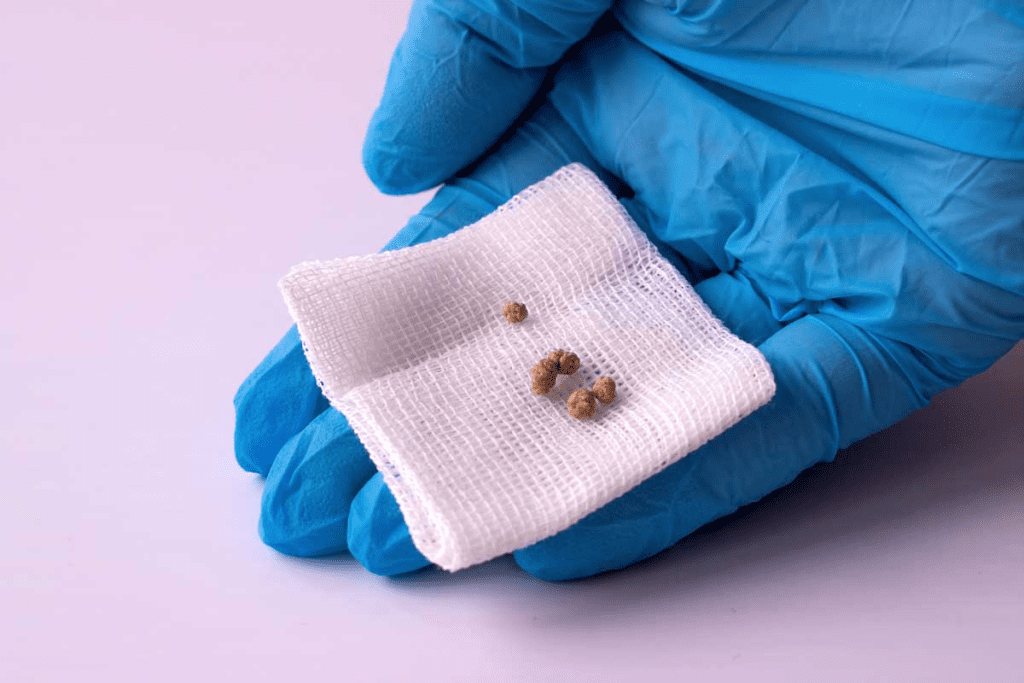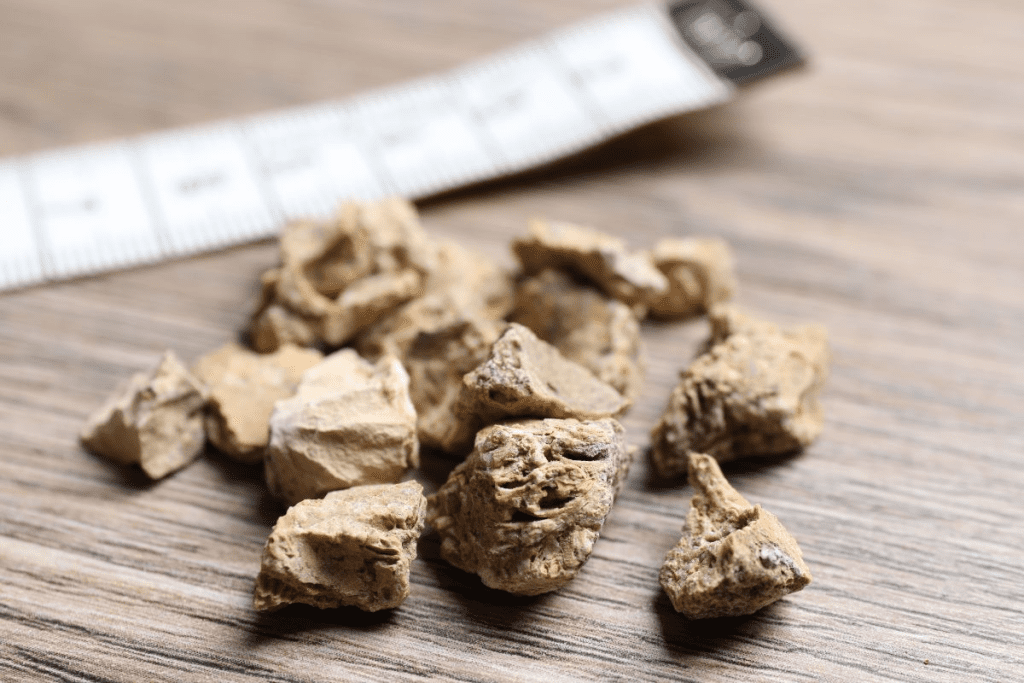Last Updated on November 25, 2025 by

We often see patients with tough-to-treat kidney stones. Extracorporeal Shock Wave Lithotripsy (ESWL) is a non-invasive method used to break stones into smaller pieces so they can pass through the urine. However, the success of ESWL depends on the stone’s size, location, and chemical makeup.
Some of the hardest stones to treat are dense types like cystine, brushite, calcium oxalate monohydrate, and calcium phosphate kidney stones. These stones often resist breaking with ESWL, making treatment more challenging. Understanding the type of kidney stone is crucial for doctors to choose the most effective treatment plan for patients.
The success of Extracorporeal Shock Wave Lithotripsy (ESWL) depends on the stone’s hardness. This factor greatly affects how well the treatment works. ESWL is a non-invasive method to break down stones into smaller pieces. These pieces can then be passed out of the body easily.
ESWL uses high-energy shock waves to break stones. These shock waves are sent through the skin and focus on the stone. The stone breaks into smaller pieces. The stone’s size, location, and hardness play a big role in how well this treatment works.

The hardness of a stone is key because it affects how easily it can be broken. Hard stones might need more shock waves or other treatments. Research on NCBI shows that knowing the stone’s composition is vital for ESWL success.
The Hounsfield Unit (HU) scale measures the density of materials, like stones, in CT scans. A higher HU value means a denser stone. Stones over 1,200 HU are harder to break and have lower success rates with ESWL. This scale helps doctors decide the best treatment plan.
Understanding stone hardness and how ESWL works helps doctors choose the best treatment. This knowledge helps manage patient expectations and plan the best way to remove the stone.
Calcium oxalate monohydrate stones are a big problem in urology, mainly with lithotripsy. They are among the hardest stones to break up with ESWL. This is because of their crystalline structure, which makes them hard to fragment.

The chemical makeup of calcium oxalate monohydrate stones makes them hard. Their crystalline structure is a big reason they resist shock wave lithotripsy. The way the crystals are packed together makes it tough for shock waves to break them up.
Some key traits of calcium oxalate monohydrate stones include:
Research shows that ESWL success rates for these stones are often lower. Their hardness and density mean they need more energy, which can raise the risk of complications.
“The management of calcium oxalate monohydrate stones remains a challenge due to their hardness and the limited effectiveness of ESWL.”
We need to look at other treatment options for these tough stones. This includes PCNL and ureteroscopy with laser lithotripsy. These methods can help improve patient results.
Brushite stones are made of calcium phosphate. They are hard and don’t break down easily with shock waves. This makes them a big problem in urology.
Brushite stones are mostly calcium phosphate. This makes them very hard. The way calcium and phosphate ions are arranged in these stones makes them strong.
These stones form in certain urinary conditions. High levels of calcium and phosphate are involved. Knowing this helps us find better ways to prevent and treat them.
Brushite stones are hard to break down with shock wave fragmentation. This is because their dense structure absorbs shock wave energy. It’s hard to break them up effectively.
So, treating brushite stones needs careful thought. We might need to try other treatments or change how we use ESWL. We’ll look at these options next.
Cystine stones are rare but very hard to deal with in urology. They form because of a genetic disorder that affects the kidneys. This disorder causes cystine to build up, leading to these hard stones. We will look into what makes cystine stones special and the treatment challenges they bring.
Cystine stones come from cystinuria, a genetic issue that affects how the kidneys handle cystine and other amino acids. This results in the formation of hard cystine stones. These stones are very hard to break up with Extracorporeal Shock Wave Lithotripsy (ESWL).
These stones are dense and often big and irregular. Their size and shape make them hard to treat with ESWL. This means other treatments are often needed.
ESWL works less well for cystine stones than for other types. Studies show that more shock waves are needed, and the stones don’t break up as well. This makes treatment outcomes less predictable. We’ll look into why this is and what it means for patients.
Because ESWL doesn’t work as well for cystine stones, other treatments like Percutaneous Nephrolithotomy (PCNL) or Ureteroscopy with Laser Lithotripsy are often used. These methods have better success rates for cystine stones.
The density of kidney stones is key to ESWL success. We’ve seen that denser stones are harder to break down with ESWL.
Stone density is measured in Hounsfield Units (HU). This scale is used in CT scans. Studies show that stone density affects ESWL success a lot.
Stones with a density over 1,000 HU are very hard. Calcium oxalate monohydrate and brushite stones are often in this group because of their dense structure.
These stones have lower success rates with ESWL. The shock waves from the lithotripter might not break them down well.
Clinical studies have given us insights into stone density and ESWL success. They show that higher-density stones lead to lower success rates and more treatments needed.
A study on ESWL for kidney stones found a big difference. Those with stones over 1,000 HU had much lower success rates. This shows how important stone density is in choosing treatments.
Knowing how stone density affects ESWL success helps us tailor treatments better. This can improve outcomes for patients undergoing lithotripsy.
We know that the size of a kidney stone is very important for ESWL success. Larger stones are harder to treat. The size of the stone greatly affects how well ESWL works.
Stones bigger than 10mm face big challenges with ESWL. Larger stones need more shock waves to break them down. This raises the risk of damage to the kidney or not getting rid of the stone completely.
Our experience shows that ESWL works less well for stones over 10mm. The bigger the stone, the harder it is to break it up completely. This is because of the stone’s makeup and how dense it is.
The size and density of a stone are key to how well ESWL works. Dense stones, like those made of calcium oxalate monohydrate or brushite, are harder to treat when they’re big.
Understanding how stone size and density affect ESWL helps us tailor treatments better. This improves results for each patient.
ESWL might not work for all hard stones. We have other treatments that can help. These options are for stones that are hard to break, like calcium oxalate monohydrate, brushite, or cystine.
PCNL is a surgery that makes a small cut in the back. It lets us remove big or complex stones. It’s better for hard or large stones than ESWL.
Key benefits of PCNL include:
Ureteroscopy uses a small scope to reach the stone through the urethra and bladder. Laser lithotripsy breaks the stone into small pieces. This is good for hard stones like calcium phosphate.
The advantages of ureteroscopy with laser lithotripsy include:
Medical expulsive therapy (MET) helps pass stone fragments after ESWL or ureteroscopy. It uses medicines to relax the ureter muscles. This makes it easier for fragments to move out.
We choose the best treatment for each patient. We look at the stone’s type, size, and where it is. This way, we make sure each patient gets the best care.
Understanding hard kidney stones is key to finding the right treatment. We’ve talked about how certain stones, like calcium phosphate or calcium oxalate monohydrate, are hard to break up with shock wave therapy.
Choosing the right treatment depends on the stone’s type, size, and density. For example, big stones or very dense ones don’t do well with shock wave therapy. Instead, treatments like PCNL or laser lithotripsy might be better.
Knowing what makes a kidney stone hard helps doctors pick the best treatment. This way, patients get the care they need, leading to better results and fewer complications.
The hardest types of kidney stones to treat with ESWL are calcium oxalate monohydrate, brushite, or cystine. This is because they are very dense and hard to break down with shock waves.
ESWL uses shock waves to break down stones into smaller pieces. These pieces can then be passed out of the body in the urine. The success of ESWL depends on the stone’s size, composition, and density.
The Hounsfield unit scale measures stone density in CT scans. It helps predict if ESWL will work by showing if stones are too dense to break down.
Calcium phosphate stones, like brushite, are hard for ESWL because they are very dense. This makes them hard to break down with shock waves.
Cystine stones are rare but very hard, making ESWL challenging. They often need other treatments like PCNL or ureteroscopy with laser lithotripsy.
Stone density is key in ESWL success. Stones with a density over 1,000 Hounsfield units are harder to break down. They might need other treatments.
Larger stones are harder for ESWL to break down. They might need more sessions or other treatments.
For hard kidney stones, options include PCNL, ureteroscopy with laser lithotripsy, and medical treatments. These might work better than ESWL for resistant stones.
PCNL is a minimally invasive surgery to remove stones directly from the kidney. It’s used for large or complex stones not good for ESWL.
Ureteroscopy with laser lithotripsy uses a small scope and laser to break down stones. The broken pieces can then be removed or passed out.
Calcium phosphate crystals in urine may mean you’re at risk for calcium phosphate stones. They could also point to other health issues.
Phosphate kidney stones form when minerals in urine concentrate. This process involves several factors.
Subscribe to our e-newsletter to stay informed about the latest innovations in the world of health and exclusive offers!